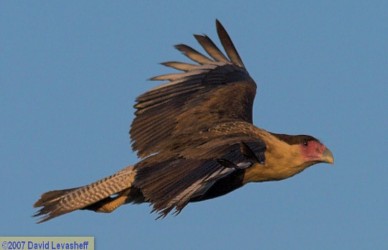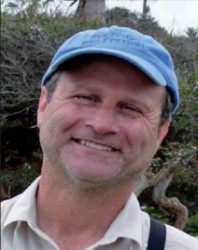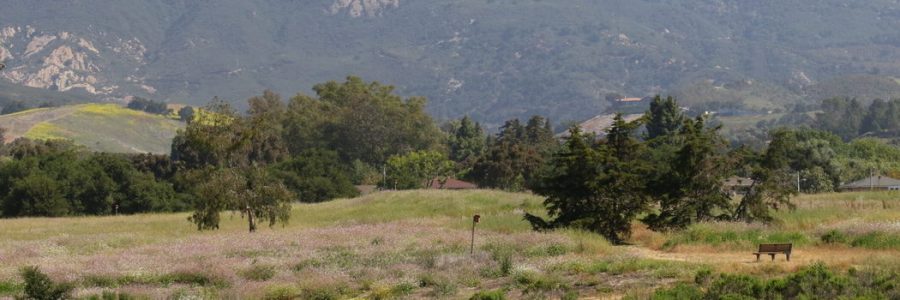The 1980s: Watching Over the Land
By Isabelle T. Walker
As published in El Tecolote August-September 2013

A Crested Caracara flies over More Mesa in 1997–a biologically diverse ocean-front parcel SBAS has been fighting to keep undeveloped since 1982.
The Gods and Goddesses who watch over birds must have been guarding our chapter in the 1980s too because, in addition to a handful of setbacks (including one very tragic one), Santa Barbara Audubon was blessed this decade with smart, energetic volunteers who considered the welfare of birds more than a pleasant avocation. It was during the 1980s that the now-famous ornithologist Paul Lehman, who had come to UCSB to complete a doctorate, joined our chapter. Not only that, he began coordinating our Christmas Bird Counts (CBC), wrote a regular column in this newsletter on noteworthy bird-sightings, testified at public hearings on County Flood Control practices, More Mesa development, the raising of Gibraltar Reservoir and more. Under Lehman’s guidance, our CBC topped the nation in 1988 with 218 species, and, with 215 species, we were just shy of the top spot in 1983.
Our chapter presidents this decade included Eileen Gray, Rob Lindsay, Chris Benech and Mary Ann Ambrose. But it was Rob Lindsay who served the longest of the group–three consecutive terms and part of a fourth. He began as Editor of El Tecolote (ET) in early 1981. But, as usually happens to good volunteers, his job ballooned. At a monthly board meeting in 1982, the twenty-something UCSB grad was nominated to be chapter president and did not say no. For several years, Lindsay served as both president and ET editor. He oversaw the chapter’s move into its first ever actual office, located at the Goleta depot, and was continually recruiting volunteers to staff it. In 1983, he alerted members to a local developer’s plan to develop multiple residences on a 330-acre parcel of coastal open space known as More Mesa. More Mesa was and is a uniquely biologically diverse area where numerous rare plants and birds thrive including White-tailed Kites, Merlins, Northern Harriers and Short-eared Owls. Lindsay, with help from other chapter leaders, spearheaded a fundraising campaign to oppose the plan, convincing the board to match donations up to $2,000.
“I remember going to the first hearing [on the project] and hearing the developer get up and say ‘birds don’t pay taxes,’ recalled Lindsay, “and then having the entire [Goleta Advisory] Council vote in favor of development, even though the university had … documented in tremendous detail how important More Mesa was biologically.”
Ultimately, the chapter joined with several other organizations to fight the project, and a benefit brunch at a local restaurant brought in $800 for a total of $4,000 raised to fight the development. In the end, the Coastal Commission nixed the project and the money was left in a legal fund for the chapter to use in future environmental battles.
Meanwhile, field trips and bird walks continued at a steady pace, and Lehman continued documenting season highlights in ET including, that year, a painted bunting present for ten days along Atascadero Creek in Goleta, a recorded first for the region.
Two watershed events happened in 1984. Over 64,000 acres of the Los Padres National Forest stretching from Big Pine Mountain Road northeast to Santa Barbara Canyon and due east to Don Victor Valley and the Ventura County line was preserved as wilderness forever in the name of Dick Smith––the larger-than-life conservationist, chapter member, artist and environmental writer who died in 1977. The Dick Smith Wilderness resulted from the persistent urging of his friends on the Trails Advisory Committee, many of whom had been chapter leaders: Jim Mills, chapter president from 1970 to 1971 and Richmond Miller, president from 1964 to 1967, were among them. Bob Easton, Kenneth Millar and Fred Eissler were also part of the group. They petitioned US Congressman Bob Lagomarsino to make the designation and Lagomarsino, a conservationist in his own right, carried the legislation through the Democratically-controlled House of Representatives and secured its passage.

The death of SBAS field trip leader Dean Bazzi in 1984 was a
tragic loss to all who knew him. Photo courtesy of Betty Bazzi
And then, in the pre-dawn hours of October 19th, Dean Bazzi, a 26-year-old UCSB grad and chapter field trip leader, was driving to Lompoc for a new job on the County Agriculture Commission when a deer ran onto the road in front of him. Swerving to avoid it, he crashed. His death was a blow to all who knew him. Bazzi had been an early protector of the Snowy Plover and spent copious hours patrolling Devereux beach, taking notes on nests and tire tracks. To honor him, the chapter funded a scholarship to the UCSB Environmental Studies program and a Botanic Garden Bird Check List. The scholarship is still going strong today.
The winter of 1984 was a good one for birding. There was a first ever sighting in the state of a Kentucky Warbler along San Jose Creek, and in the spring, Lehman saw a Belted Kingfisher in Goleta. Meanwhile, Columbia University sold More Mesa to a Sun Valley resort owner named Earl Holding, bringing a fresh infusion of uncertainty to the land’s future. Once again, chapter members were sent to their writing tablets and computers to urge county supervisors to preserve it as open space.

Paul Lehman, ornithologist extraor-dinaire and SBAS chapter member,
coordinated chapter CBCs for over a
decade.
In 1985, Fess Parker’s monolithic hotel proposal came before the City. The chapter opposed it, judging it overly large and too great a drag on water resources. The airport proposed expanding a runway into the Goleta Slough and in 1986, the Western regional office of National Audubon Society reported only two pairs of Condors were currently nesting in California. That meant three pairs had lost mates in the previous year––an inauspicious sign if there ever was one.
Everyone knows a smaller version of Fess Parker’s hotel was approved but not everyone knows the City released a surprisingly sensitive Airport Master Plan in the mid-80s that included some of the best natural history and biology found in this kind of document, according to Mark Holmgren, retired curator of UCSB’s Vertebrate Collection, expert birder and chapter member. The plan led to the formation of the Goleta Slough Management Committee (GSMC), which Holmgren joined, as did, in later years, our recently retired chapter president, Darlene Chirman. Pat Saley, who staffs the GSMC, said the airport’s two runways each needed to have Runway Safety Areas of 1,000 feet. When that additional footage was created two years ago, Tecolotito Creek, which feeds the slough, was shifted west towards Los Carneros Road. But according to Saley, SBAS has been involved in the planning of this all along. “Whatever is done there is done in the most environmentally sensitive manner,” said Saley.
In the second half of the decade, the California Condor’s existence on the planet was hanging by a thread, with more birds dying and infighting among those working to save it. In 1986, when Chris Benesh was chapter president, the U.S. Fish and Wildlife called for the removal of all remaining California Condors from the wild. There were not many to begin with but even so, little consensus existed among our chapter’s roughly 1,200 members. Even National Audubon filed an injunction to prevent it. It failed however and the last wild Condor, AC-9 was ultimately trapped by cannon net and taken to the San Diego Zoo.
“AC-9 was one who entertained me two summers past, although I support the recovery program, I can’t help think of how much more promising the current program would be if it had begun 50 years earlier.”
Another battle joined that year was County Flood Control’s practice of indiscriminately destroying habitat in local creeks, including Atascadero and Carpinteria–habitat responsible for making Santa Barbara a magnet for birds. An informal agreement between birders and the department as to the amount of clearing that would take place was ignored and again, protest letters from SBAS members were urged and sent to County Supervisors. In September 1987, after public hearings that included testimony from Lehman and other biologists, Flood Control agreed to hire a biologist to help them find less destructive ways of clearing creeks beds.
Any chapter member wanting a break from activism had to have been disappointed that year because the City’s plans to raise the level of Gibraltar Reservoir were adding to the Least Bell’s Bireo’s many troubles. SBAS––whose own vice president in 1982, Jim Greaves, single-handedly discovered what turned out to be the largest population of Least Bell’s Vireo in the state––stood in strong opposition. Any raising of the water level in Gibraltar would submerge Mono Creek, our activists asserted, which was part of the vireo’s critical habitat. Thanks primarily to Greaves’ biological studies for the US Fish and Wildlife, the plan was abandoned.
In 1988, Santa Ynez Valley formed its own chapter, La Purisima, and a new system of dues splitting with National Audubon began draining our finances. No Dick Smith or Golden Trout Camp scholarships were given and no donations were made to conservation projects. Joy Parkinson, a chapter founder and never one to be trifled with, wrote the chapter’s first direct appeal to the membership for donations. “We have over 900 members,” Parkinson wrote, “If everyone gave one dollar, we could print two more issues of ET or give a Dick Smith and Golden Trout Club scholarship to two recipients.”
While the chapter was settling into new digs at the Goleta Valley Community Center, a fetching dark-eyed owl with spots inhabiting old-growth forests in the Pacific Northwest was taking center stage in a national controversy over the conflict between habitat and economic interests. At once, the nation was awake to the fact that birds’ survival can’t be taken for granted, and that, amid myriad pressures and interests at work in the modern era, there were times when people were going to have to make a lot of noise on their behalf.

